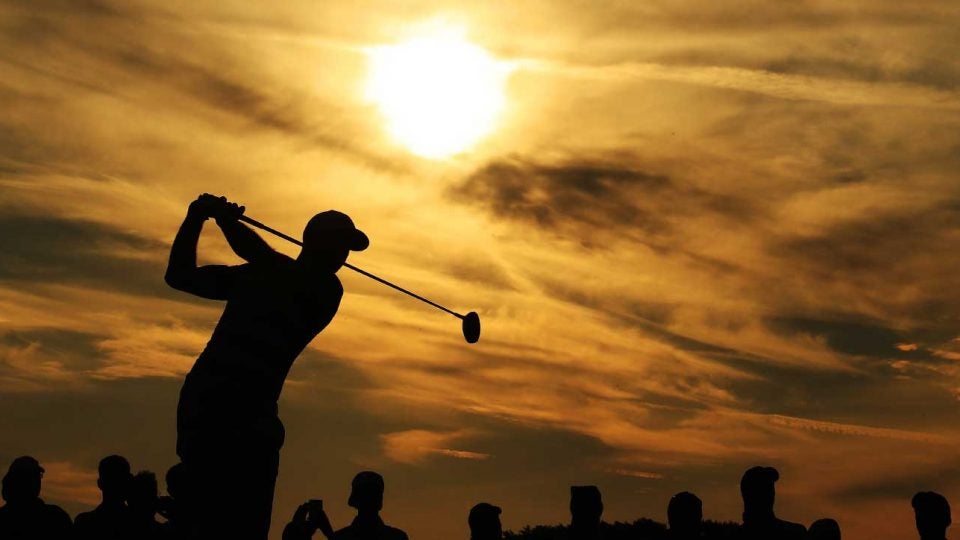 2024 Wyndham Championship: How to watch, TV coverage, streaming info, tee times
2024 Wyndham Championship: How to watch, TV coverage, streaming info, tee times
Tour Confidential: Could the Distance Report change the game as we know it?

In this week’s Tour Confidential, we break down the impact of the USGA and R&A’s Distance Insights Report, including what it could mean for the future of the game. Check in every week for the unfiltered opinions of our writers and editors as they break down the hottest topics in the sport, and join the conversation by tweeting us @golf_com.
1. The governing bodies dropped their much-anticipated Distance Insights Project on Tuesday. The message in the strongly worded, deeply researched document was clear: the time has come to nip distance in the bud. “We believe that golf will best thrive over the next decades and beyond if this continuing cycle of ever-increasing hitting distances and golf course lengths is brought to an end,” read the USGA’s accompanying conclusions report. The organizations proposed two primary means by which they might address the issue — (1) modifying equipment specifications, and (2) instituting a local rule that would allow committees to run tournaments with limited-flight equipment — but nothing will happen until at least the end of 9- to 12-month feedback period. Did the report signal to you that the governing bodies are finally on the verge of taking significant action?
Michael Bamberger, senior writer: A local rule is not significant UNLESS AUGUSTA NATIONAL decides to put in use. That would seem unlikely. (But cool if it ever happened.) The USGA needs to build a consensus that SHORTER IS BETTER among a group of constituents who don’t believe that’s the case. Golf has a long history of NOT TAKING REVOLUTIONARY ACTION. I’d love to see something happen here. Hard to see how it will.
Luke Kerr-Dineen, instruction editor (@LukeKerrDineen): LKD: The ‘woke’ golf crowd loves to rag on the USGA, but it must be said: The organization has been on a winning streak with a series of decisions recently, and this report was one of them. Fans love to point to how quickly swimming banned those suits after the 2008 Olympics, and how seamlessly college baseball dealt with its distance problem, but golf isn’t like other sports. To tackle the distance problem in golf, the USGA has to manage a series of big business and other multimillion-dollar interests that make it an almost no-win situation. They’ve responded by going slowly but diligently. Doing research, but making sure everybody is on board, and acting in a way that’s good for the game. It may take slightly longer than many golf fans want, but I firmly believe that slow and steady will win the race. Golf will reign in this problem, and will do so in a way that won’t erupt a civil war in the process.
Josh Sens, senior writer (@JoshSens): It’s hard to imagine anything happening quickly on the equipment front. The commercial interests working in the other direction are just too strong. In the short run, the bigger impact I can see it having is on raising awareness of/and promoting interest in shorter courses, modified rounds and other options. These things allow people to play without having to devote an entire day to it and make golf more economically and ecologically sustainable. If progress is made on that front, that would be a welcome change.
Dylan Dethier, senior writer (@Dylan_Dethier): I guess it depends what’s considered “significant action.” The USGA’s stance that increased distance is bad for golf felt very significant. But they also made it clear they’re not looking to significantly roll back equipment; if that’s the case, driving distance will continue to creep up as players continue to bigger, stronger, more athletic. If people are looking for radical change, I don’t think we’re going to get that — but something will happen.
2. Distance is decidedly not a problem for most amateurs. In fact, the conclusions report states that average players largely don’t hit their drives far enough for the tees from which they’re playing, and that at most courses even the shortest tees are too long for the shortest hitters. Is the handwringing over distance an overreaction to what’s happening in the pro and elite amateur ranks?
Bamberger: Bifurcation is a loaded word and not the correct word for this situation. Virtually all non-elite golf is played by some casual version of the rules, by which the parties agree for play in accordance with rules they devise. Elite players play courses that are, in terms of distance, WAY shorter than the courses we play: 7,500 for them is 6,000 for most of us, but we creep up at the pros creep up. One simple starting point is to make ordinary male golfers comfortable with 5,900 yards (get of the “6,000” stigma). For women, take off at least 1,000 yards. A straight 470-yard par-5 is plenty of hole for most of us. #mindset.
Kerr-Dineen: It speaks to the overriding issue that, unlike basically every other sport, golf has to manage the recreational and professional levels simultaneously, when they are essentially different games, with completely different sets of problems. It’s why I’ve always come down on the side of bifurcation and, frankly, have never fully understood the counterargument.
Sens: The report makes a pretty compelling case for all the ways distance is hurting the game, so in that sense, I don’t think it’s an overreaction. A more persuasive argument could be made that it’s too mild a response, issued too late.
Dethier: Several of us were on a call with the USGA in which they made it explicitly clear they’re not going the bifurcation route. “We play under a single set of rules, we believe in that strongly, it’s a strength and virtue of the game and we’re steadfast in retaining that,” Mike Davis said. But yes, most players should move up tees, get their egos out of the way, play faster and have more fun. This wasn’t just a “distance is bad” report — it took a look at distance, period.

ADVERTISEMENT
3. Many Tour players were predictably dismissive of the report. “I didn’t really read anything tangible from the report; I only saw that they didn’t want each generation to continue getting longer and longer,” Phil Mickelson said. “I struggle with some of our governing bodies. I struggle with it because we are the only professional sport in the world that’s governed by a group of amateurs, and that leads to some questionable directions that we go down.” Does Lefty have a point?
Bamberger: Lefty made a point but I would say different from the one he was trying to make: the amateurs who run the USGA and the R&A–in concert with a group of highly trained professionals–aren’t looking to make money in the game. That keeps them pure. Pro golfers are typically trying to move product in the interest of making more money. The amateurs who serve at the USGA and the R&A have something broader in mind.
Kerr-Dineen: Truth be told, I never put much stock in anything pros have to say about larger issues about the game of golf. Why? Because pros operate in a bubble, trying to play better tomorrow to cash a check and maximize their career, without much thought about larger industry factors. More credit to them. I’d do it; you’d do it; any rational person in that situation would act the same way. But it also means that basically everyone in that position is going to defend the status quo. Lefty isn’t necessarily wrong, but the subtext of his comments — and like most pros’ comments on the matter — is always the same: That pros think that they should be able to do whatever they want, and that the rest of the game should follow along diligently.
Sens: In fairness to Mickelson, he acknowledged that he was speaking of the cuff, which I was glad to hear because almost nothing he said about the report stood up to much scrutiny. Amateurs hold sway over all kinds of sports. I’m pretty sure I could beat Adam Silver in a game of one-on-one hoops. Mickelson’s comments about golfers being punished for improving their skills were even more head-scratching. The argument against distance is that it’s making the game a one-dimensional test, requiring a narrower range of skills.
Dethier: It’s easy to snipe at the USGA, and pros have delighted in doing just that in recent years, but I think the only legitimate criticism in this case is that the governing bodies haven’t acted quickly enough. There’s no silver bullet solution now, which means to some extent, the governing bodies can’t please everyone. That opens them up to criticism — but they’re used to that.
4. Nick Taylor did Canada proud by outdueling Mickelson in their Sunday pairing to win the AT&T Pebble Beach Pro-Am. Another storyline was the strong performances by a pair of superstars who have been struggling to find their way: Jason Day, who finished 4th, and Jordan Spieth, who shot the lowest score in the field Sunday (67) to finish 10th. Day came into the week ranked 46th in the world; Spieth came in ranked 55th. Who is most likely to climb back into the top 10 first?
Bamberger: Spieth. He’s in that window–no kids, nothing really else going on his life–where he can devote himself to fixing his golf problems. That doesn’t mean he can but he’ll have more opportunity and likely has more incentive to do so.
Kerr-Dineen: Probably Jason Day. Spieth seems to be facing different problems for each aspect of his game. Day’s issues don’t seem to be as deep-rooted, and when you can roll the ball like he does, you can never truly count him out.
Sens: I’m a Spieth believer. There’s just too much fire and fight in him for him to go quietly.
Dethier: Spieth! He wasn’t great off the tee on Sunday, but he showed off some sensational ball striking and a tight short game. My biggest concern with Day is his health; it was just December when he withdrew from the Presidents Cup and told his wife Ellie that his career might be close to finished. Plus, read this quote: “As you’re an injured player, you think, maybe my time is just coming around the corner, and I might have to rack the clubs. And that’s a really terrible way of seeing it because I am only 32.” Considering Spieth couldn’t break an egg on Sundays last season, this was encouraging.
5. Brooks Koepka says he’s opposed to golf broadcasts conducting interviews with players mid-round, a practice that is common on the European tour but not the PGA Tour. “I’m not interested in talking about what just happened or the difficulty of the holes ahead,” he said. “I understand why it might be beneficial for the fans, but I don’t get it.” Do you see enough upside for fans that PGA Tour telecasts should consider adding mid-round interviews to their offerings?
Bamberger: Absolutely not. These are supposed to be athletic contests. Our entertainment is a mere byproduct of the golfers trying to do a difficult thing well. Let them work in peace. It’s hard enough. They talk before and after. That’s plenty and often too much as it is.
Kerr-Dineen: Yes. Once again, pros are always going to hate and object to things that take them out of their little security bubble where they like to play their golf, uninterrupted. But that doesn’t matter. At the end of it, the players an entertainment product, and mid-round interviews make the product more enjoyable for fans at home — the people who are actually paying the bills.
Sens: I’m with Luke. Plenty of upside. If Koepka is game, leave him be and find players who are up for it and have something interesting to say.
Dethier: Yes! Mostly, we just want to see golf shots, but anything that could give us a little more insight into the guys hitting them would be a win. Mic’d up players remains the pipe dream.
6. We asked our Top 100 Teachers for their takes on the worst kind of advice you can give a golfer. (“Keep your head down” was the runaway winner.) What’s the most regrettable piece of golf advice someone has tried to impart on you?
Bamberger: Swing to right field. Don’t swing to right field unless you went to hit quick hooks. All the best divots go to short.
Kerr-Dineen: I’ve been given so many bad pieces of advice over the years it’s genuinely tough to remember. Ultimately, ‘bad’ golf advice is subjective and will be different for everyone. The key is recognizing bad advice the second you hear it. The best way to do that? If someone is telling you something that feels completely foreign to you — unnatural, physically awkward and uncomfortable — stay away.
Sens: It always seems like a bad idea for amateurs to study putts from multiple angles. In my experience, it usually leads to conflicting reads and it always leads to slow play.
To receive GOLF’s all-new newsletters, subscribe for free here.
ADVERTISEMENT







